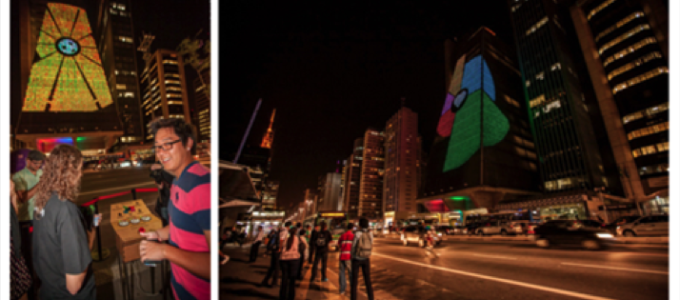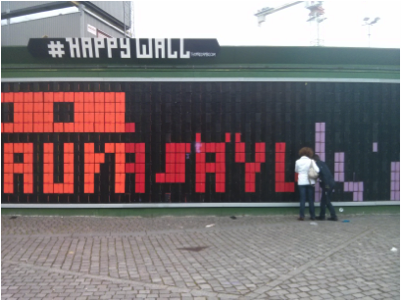The 3rd International Symposium on Pervasive Displays 2014 in Copenhagen
A summary by Moritz Behrens
After having presented a paper [1] at the International Symposium on Pervasive Displays last year, I aimed to approach the research community this year again. At PerDis has always been exciting research presentations with a technical as well as an applied perspective towards pubic displays. In particular I was interested in joining this year’s conference, as media facades seem to become a growing research area within the public display domain.
The 3rd International Symposium on Pervasive Displays (Per Dis) took place at the University of Copenhagen, Denmark during June 3rd and 4th 2014. The conference was organized by Sebastian Boring (General Chair) and Aaron Quigley (Program Chair). Monday evening started with a welcome reception on a boat taking us through the channels of Copenhagen.
The conference kicked off on Tuesday with a keynote by Peter Dalsgaard from Aarhus University. Peter summarised his research on HCI and media facades by presenting identified challenges when designing, deploying and researching interactive urban media installations. He argued that large-scale public displays such as media facades, are a new medium, which researchers are only beginning to understand. Hence new forms of content suiting this medium will need to be explored in more detail. Consequently the development of new techniques and tools to explore the design space frame key aspects of working in this field. At the same time urban places host a variety of situations and practices, which therefore require the design of systems that are flexible enough to accommodate these activities.
With this keynote in mind the presentation of our paper ‘Smart Citizen Sentiment Dashboard: A Case Study Into Media Architectural Interfaces’ [2] at the end of the first paper session fit well into this spirit. We introduced the notion of media architectural interfaces (MAIs), which describe the relation between users engaging with dynamic content on media façades through tangible artifacts on street level. We then illustrated the notion of MAIs through reporting on the technical set up of a field study, in which we deployed a novel tangible user interface (TUI), called the Smart Citizen Sentiment Dashboard (SCSD). This device gives citizens the opportunity to express their mood about local urban challenges. The input from this TUI is then instantly displayed on a very large (3700 sqm) media façade. As a result of this study we identified emergent behavior in the immediate space around the TUI and the wider urban space. We contributed with this paper through highlighting challenges in the design and deployment of large-scale media architectural interfaces. Questions at the end of our presentation were mainly asking if we could measure the impact of our installation on decision-making processes of stakeholders. Unfortunately we had to admit that the deployment period was simply too short for identifying any impact on stakeholders.
Figure 1: Picture from the Smart Citizen Sentiment Dashboard paper.
In the further course of the following paper sessions I will only highlight the once that I consider relevant to my research.
Fabius Seeburger’s paper [3] presentation was about the physical Yes/No buttons, which enable people at a bus stop to ‘Vote With Your Feet’. The system was used as a platform for Local Community Polling on Urban Screens. One aim of this set up was the exploration whether this kind of interface on foot level might lower participation barriers. Fabius found some indications suggesting that participants feel enticed to step on the buttons on foot level.
Another research that has been conducted at QUT in Brisbane, Australia was presented by Markus Rittenbruch [4]. He introduced a framework called CubIT, which is a multi-user, large-scale presentation and collaboration framework. In his paper he applied this framework on the novel interactive display (The Cube) at the new Queensland University of Technology premises in Brisbane, Australia. The studied prototype gave personalized access to the new display through an RFID interface. It allows logging in through participants’ building access cards. As a result challenges of getting access and creating meaningful applications for this particular multi-touch interface were presented.
In this sense Nick Gillian from MIT Media Lab presented an ecology of about 100 networked sensors and 30 public displays across the Media Lab building [5]. The set up gave passers-by the opportunity to access personalized data through facial recognition and browsing their data through gestures.
As these novel possibilities for a more tailored usage of public displays comes with privacy issues such as users feel observed when entering their passwords on public displays, Frederik Brudy demonstrated design methods that make it harder for passers-by to do “shoulder surfing” one’s content [6].
From a more technical perspective this year’s PerDis conference explored ‘Scheduling Interactive and Concurrently Running Applications in Pervasive Display Networks’ [7] or ‘Tandem Browsing Toolkit: Distributed Multi-Display Interfaces with Web Technologies’ [8].
A few projects that were outstanding as they challenged the PerDis community conceptually were the megaphone project by researchers from Montreal [9] and Lisa Koeman’s project [10], who aimed to get “research in the dark” back into day light through turning pavements into chalkboards for community purposes.
At the very end of all paper sessions there was a critical position paper by Simo Hosio [11] who challenged the common assumption of the purpose of public displays and their economic value.
In addition there have been three video presentations of projects, which included ‘The ‘Making of’ MÉGAPHONE, an Interactive “Speakers’ Corner and Digitally-Augmented Agora in Public Space’ as well as the launch of our documentary about the UCL research project: ‘Screens in the Wild: Exploring the Potential of Networked Urban Screens for Communities and Culture’.
In summary, I appreciated the diverse paper sessions and the high quality of the research findings. Overall I got the impression that this year’s PerDis conference was focusing on how to customize access to public displays. In other words, new toolkits and frameworks are have been explored that let user access their private data on a public display. I assume that this might be an attempt to intervene recent observations from UBIOulu researchers who found out that their public Wi-Fi network, which allows people to connect their individual mobile interfaces to the internet, increasingly becomes popular whereas the usage of the embedded public displays (Ubi Hotspots) drops [12].
However, I wished that there had been more discussions around certain topics, as the few minutes of Q&A after each paper presentation was not touching certain topics in depth. In this sense, Simo Hosio’s attack on popular public display assumptions would have enriched a critical view on our work in this field. Panel discussions at the end of each paper session might have been a way to provide this platform. Also the paper sessions could have been more arranged in accordance to the topics of the presented papers.
The demo and poster session, which took place in the evening of the first day, did not quite get the stage they deserved.
Figure 2: Happy Wall
Peripheral activities:
On Monday I gave a talk about my “Screens in the Wild” involvement and current PhD research at the Copenhagen Business School in the Department of IT Management. There is a small research group that aims to explore the smart city from an ethnographical research perspective.
Right after the conference finished, I went to see a talk by Christian Kray from the ‘Institut für Geoinformatik der Universität Münster’ at the Copenhagen Institute of Interaction Design (CIID). Christian presented his recent research about navigation of dense crowds through public displays and a DIY cave (iPED), which allows designers to do rapid prototyping of public displays in urban context. Followed by a tour through the CIID facilities and an introduction to staff and researchers.
Of particular interest in Copenhagen was the recently opened Happy Wall. It is basically an analog low-resolution display, made out of rectangular wooden tiles. On one side the tiles are painted in black. On the inner side they are coloured. Mounted with flexible hinges to a construction wall of a major construction site on a central square in Copenhagen the tiles can be manually flipped by people. Consequently participants were able to create colourful patterns or write names.
References and selection of PerDis publications:
[1] Behrens, M., Fatah gen. Schieck, A, Kostopoulou, E., North, S., Motta, W., Ye, L., Schnädelbach, H. (2013). Exploring the effect of spatial layout on mediated urban interactions. In: (Proceedings), PerDisp’13: The International Symposium on Pervasive Display. ACM library
[2] Behrens, M., Valkanova, N., Brumby, D., Fatah, A. (2014). Smart Citizen Sentiment Dashboard: A Case Study Into Media Architectural Interfaces. In: Proceedings, PerDis’14: The International Symposium on Pervasive Display, Copenhagen, Denmark. ACM library
[3] Steinberger, Fabius, Foth, Marcus, & Alt, Florian (2014) Vote with your feet : local community polling on urban screens. In Third International Symposium on Pervasive Displays, 3-4 June 2014, Copenhagen, Denmark.
[4] Rittenbruch, Markus (2014) Evaluating the use of a very large-scale presentation and collaboration framework. In Proceedings of the 3rd International Symposium on Pervasive Displays, ACM Press and Digital Library, Copenhagen, Denmark.
[5] Gillian, N., Pfenninger, S., Russell, S., Paradiso J. (2014) “Gestures Everywhere: A Multimodal Sensor Fusion and Analysis Framework for Pervasive Displays” in 3rd International Symposium on Pervasive Displays (PerDis’14), Copenhagen, Denmark, June 2014
[6] Brudy, F., Ledo, D., Greenberg, S., Butz, A. (2014) “Is Anyone Looking? Mitigating Shoulder Surfing on Public Displays through Awareness and Protection”
[7] Elhart, I., M. Langheinrich, N. Memarovic, and T. Heikkinen (2014) “Scheduling Interactive and Concurrently Running Applications in Pervasive Display Networks”
[8] Heikkinen, T., J. Goncalves, V. Kostakos, I. Elhart, and T. Ojala (2014) “’Tandem Browsing Toolkit: Distributed Multi-Display Interfaces with Web Technologies”
[9] Fortin, C., Hennessy, K., Sweeney, H. (2014)“Roles of an Interactive Media Façade in a Digital Agora”
[10] Koeman, L., Kalnikaite, V., Rogers, Y., Bird, J. (2014) “What Chalk and Tape Can Tell Us: Lessons Learnt for Next Generation Urban Displays”
[11] Hosio, S., Goncalves, J. , Kukka, H., Chamberlain, A., Malizia, A. (2014)“What’s in it for me: Exploring the Real-World Value Proposition of Pervasive Displays”
[12] Luusua A, Ylipulli J & Ojala T (2013) Situated displays vs. municipal WiFi: Comparing the interactivity of two public infrastructures. CHI 2013 workshop Experiencing Interactivity in Public Spaces (EIPS 2013), Paris, France.
Biography:
Moritz Behrens is an architect and maker, an interaction designer and researcher aiming to combine architecture with human-computer interaction. His work focuses on technology-mediated interactions in urban spaces, which support citizens and communities to engage with social challenges in their city. His recent project aims to design, deploy and research media architectural interfaces that are built on tangible user interfaces as mediators between citizens and interactive media facades. As part of the EU funded “Connecting Cities” network and in collaboration with Nina Valkanova, Moritz has been invited to produce an installation for the Ars Electronica festival later this year.
Currently Moritz is a PhD candidate at UCL The Bartlett in London. Previously he was employed as research associate in the EPSRC funded ‘Screens in the Wild’ project at UCL The Bartlett, which explored networked urban screens for empowering communities.
Moritz has been working as an architect in residential and exhibition projects in Berlin. In London he has been working in different practices as a design consultant for major retail companies. Prior to that he gained a MSc in Adaptive Architecture and Computation from UCL The Bartlett in 2011 and received a masters in architecture from Technical University of Berlin in 2009. Moritz started his career working as a cabinetmaker in the south of Germany.



